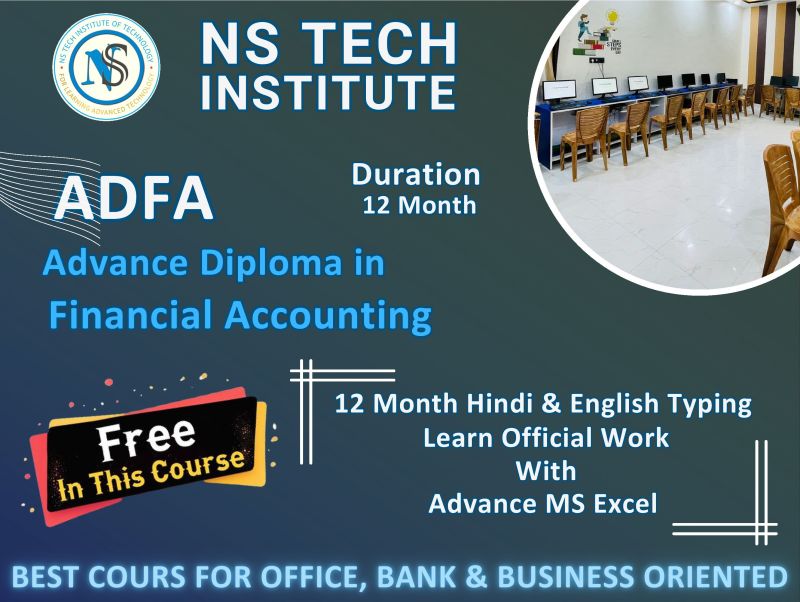
FUNDAMENTAL OF COMPUTER
1. Introduction: - What is computer, History of a computer; Shortcut Keys, Full form of Computer
2. Type of Computer : - Based on Mechanism, Based on Size, Based on Purpose
3. Components of PC : - Computer System, Computer Hardware and Software
4. Input/Output (I/O) Devices : - Input Devices, Output Devices
INTRODUCTION TO INTERNET
1. History of the WWW
2. LAN WAN & MAN
3. Creating an Email Account
4. Browsers and Search Engines
5. Surfing and Searching
OPERATING SYSTEM
1. Basics of Operating System
2. User Interface of OS
3. Operating System Simple Setting
4. File and Folder Management
5. Paint, Notepad & Wordpad
MS OFFICE
1. MS Word :- Create Paragraph, Text Formatting, Change Case, Border, Page Border, Paragraph and Line Spacing, Styles & Editing, Create Table, Chart, Smart Art, Shapes, Hyperlink, Bookmark, Header & Footer, Text Box, Word Art, Object and Text from File, Page Setup, Page, Background, References, Mailings, Comment, Document View, Split Window, Show/Hide, Macro, Protect Document
2. MS Excel:- Insert and Delete (Cells, Rows, Columns and Worksheet), Font, Alignment, Number Formatting, Hide & Unhide (Rows, Columns, and Worksheet), Workbook, Worksheet and File Protect, Customization, Data Fill, Merge Cells, Conditional Formatting, Formatting, Split Window, Freeze Panes
EXCEL FORMULAS:- 40+ Count
Math Function (Sum, Round, Int, Mode)
Stats Function (Count, Average, Max, Min)
Text Function (Upper, Lower, and Proper)
Logical Function (If, Count If, Count Ifs, Sum If, Sum Ifs, Lookup, Vlookup, Hlookup)
Salary Creation, Salary Distribution, Business Recept slip, and Mark Sheet
Sort, Filter, Group & Ungroup, Remove ungroup, Remove duplicates.
3. MS Power Point: - Create and Manage Presentations; Insert and Format Text, Shapes, and Images; Insert Tables, Charts, SmartArt, and Media. Apply Transitions and Animations
ACCOUTING WITH TALLY
1. Introduction of Tally:- Easy calculation of TDS (Tax Deducted at Source), Interest calculation in, maintain balances bill by bill, Purchase/Sales Order, Inventory Report, VAT (Value Added Tax), Payroll, Manage Stocks, Manage Vouchers, Daybook, Display Balance Sheet.
2. Gst & Taxation:- Goods and Services Tax (GST), Purchase Voucher with GST, Sales Voucher with GST, GST Returns and Payment
3. Ledgers & Voucher:- Payment Voucher, Receipt Voucher, Contra and Journal Voucher, Purchase Order Processing, Sales Order Processing, Debit and Credit Notes
4. Inventory & Stock:- Masters – Ledgers, Masters – Groups, Masters: Inventory, Stock Transfers
5. Balance sheet:- Batch Wise Details, Purchase and Sales Reporting, Stock Analysis and Reports, Printing Reports
6. Profit & Loss
7. Payroll:- Payroll Accounting in Tally
HTML
1. INTRODUCTION OF HTML
i. HTML (Hypertext Markup Language) Is A Markup language used by the browser to manipulate text, images, and other content, in order to display it in the required format.
ii. HTML was created by Tim Berners-Lee in 1991. The first-ever version of HTML was HTML 1.0, but the first standard version was HTML 2.0, published in 1995.
iii. HTML is the code that is used to structure a web page and its content.
iv. HTML is the language for describing the structure of Web pages. HTML gives authors the means to: Publish online documents with headings, text, tables, lists, photos, etc. Retrieve online information via hypertext links, at the click of a button.
v. Web browsers receive HTML documents from a web server or from local storage and render the documents into multimedia web pages. HTML describes the structure of a web page semantically and originally included INTROIcues for the appearance of the document.
2. INTRO TO HTML SYNTAX
i. The HTML, head, title, & body tags Headings, paragraphs, & lists The strong & me tags The doctype The lang attribute The meta tag & the Unicode character set.
ii. Absolute & Relative URLs
iii.Anchor tags & hers Linking to other websites Linking to pages within a website Opening a link in a new browser window/tab. Adding Images The break tag The image tag & source attribute Using the width, height, & alt attributes Using horizontal rules.
C LANGUAGE
1. Introduction to the C Language : - Algorithm, Pseudo code, Flow chart, Background, C Programs, Identifiers, Data Types, Variables, Constants, Input / Output, Operators(Arithmetic, relational, logical, bitwise etc.), Expressions, Precedence and Associatively, Expression Evaluation, Type conversions.
2. Statements & Looping : - If and switch statements, Repetition statements ( loops)-while, for, do-while statements, Loop examples, other statements related to looping – break, continue, go to, Simple C Program examples.
3. Functions : - Introduction to Structured Programming, Functions- basics, user defined functions, inter function communication (call by value, call by reference), Standard functions. Storage classes-auto, register, static, extern, scope rules, arrays to functions, recursive functions, example C programs.
4. Arrays : - Basic concepts, one-dimensional arrays, two – dimensional arrays, multidimensional arrays, C programming examples.
5. Pointers : - Introduction (Basic Concepts), pointers to pointers, compatibility, Pointer Applications, Arrays and Pointers, Pointer Arithmetic, memory allocation functions, array of pointers, pointers to void, pointers to functions, command –line arguments, Introduction to structures and unions.
6. Strings : - Concepts, C Strings, String Input / Output functions, string manipulation functions, string /data conversion. Input and Output Concept of a file, streams, text files and binary files, Differences between text and binary files, State of a file, Opening and Closing files, file input / output functions (standard library input / output functions for files), file status functions (error handling), Positioning functions.